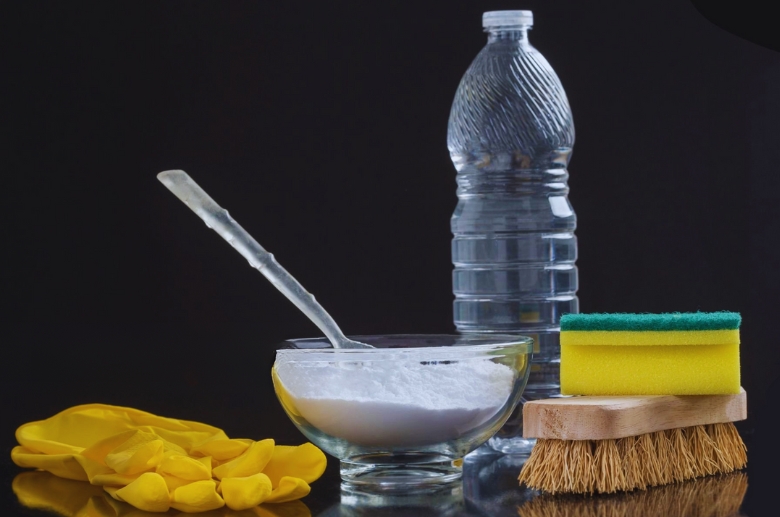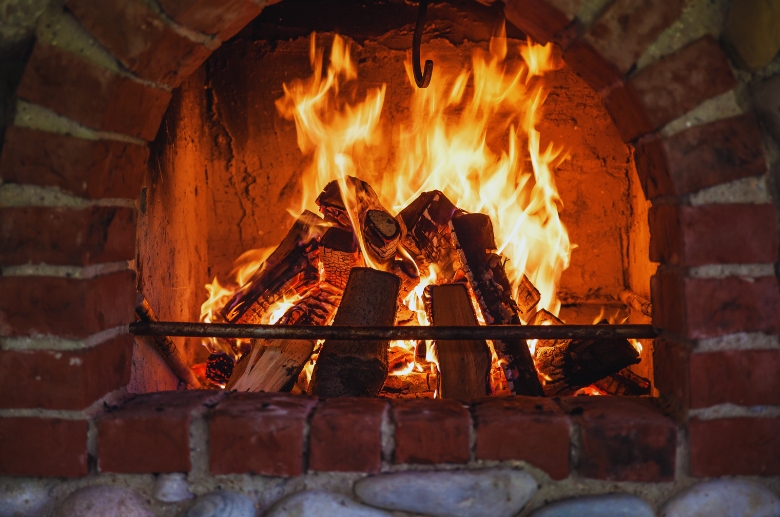A fireplace in the living room can be a wonderful addition for a visually appealing hearth all year round. However, with every fireplace comes the accumulation of fireplace brick soot.

With the right cleaning solutions and a little bit of elbow grease, you can get those bricks clean in no time. We’ll teach you how to clean fireplace brick soot, what causes soot in the first place, and how you can prevent its buildup.
How To Clean Fireplace Brick Soot
If you notice soot collecting on your fireplace bricks or chimney, follow this step-by-step guide. But first, let’s talk about tools and materials. There are things you need to prepare and safety precautions you need to take before you can begin the cleaning process.
——
Do You Need to Hire Chimney & Fireplace Expert?
Get free quotes from qualified experts near you. No commitment required!
——
Tools and Materials
These are the tools you’ll need to clean the soot from your brick fireplace.
- Mini broom
- Dustpan
- Spray bottle
- Bucket
- Vacuum
- Scrub brush
- Disposable rubber gloves
- Mask
- Eye mask or eye goggles
- Masonry sponge
- Paintbrush
- Waterproof drop cloth
- Tarp
Safety Precautions Before You Begin
While cleaning fireplace brick soot is a rather straightforward task, you might be working with harsh cleaners. Here’s how to protect yourself and your house while doing the job.
- Make sure the fireplace is completely cold before cleaning. A good indicator is the color of the ash. If it’s white, not gray, it means it has completely cooled. You then want to get rid of any heat source that was used previously.
- Since you are working inside your home, place a water drop cloth over areas that you don’t want wet or stained. To protect furniture and appliances, cover them with a tarp.
- Wear protective gloves and a mask. These are to protect your skin, eyes, and lungs from dust particles and the effects of harsh chemical cleaners.
- Ensure good ventilation to air out smells from harsh chemicals.
- Prepare a designated workspace to contain the cleaning process.
Step 1. Dry Brushing and Vacuuming

If you use a grate in your fireplace, take it out first. Then, clear out the ash from the fireplace with a shovel or a mini broom. Put the ash away in an ash bucket.
Next, vacuum any remaining dust, debris, and soot. You want the fireplace to be dust-free before washing the bricks.
Take any flammable items away from the fireplace area. You want to protect your home against a fire caused by any remaining ash in the fireplace.
Step 2. Prepare The Cleaning Solution

Before applying any cleaning solution, saturate the bricks with plain water. Brick is very porous and will absorb cleaning solutions immediately, resulting in discoloration. Spraying the brick with water creates a barrier inside it, preventing it from absorbing the cleaning solution.
Once you’ve gotten the bricks wet, it’s time to apply a cleaning solution. You have several ways of doing this. The method will depend on the age of your bricks and the amount of soot buildup.
Generally, you want to start with the gentlest cleaner possible to avoid damaging your bricks. The older the brick, the more special care it requires.
For light stains:
- Dishwashing detergent: This is the mildest cleaner, ideal for light stains, and safe to use even on older bricks. Dilute ¼ cups of dish soap in four cups of water.
- Vinegar: Mix white vinegar with equal parts water. You can control the concentration as needed. A weaker solution will have less vinegar and more water, while a stronger solution will have more vinegar and less water. Just be careful not to use it on bricks that are more than 20 years old. Vinegar may be a good cleaning agent, but due to its acidic nature, it can be too abrasive on older bricks.
- Salt and soap: Combine regular table salt with soap for a gentle yet effective cleaning solution for soot. This method is perfect for cleaning bricks while avoiding harsh chemicals.
For stubborn stains:
- Borax: If you’re working with more stubborn stains, use Borax. This substance is alkaline in nature, perfect for neutralizing acidic soot. It’s also mildly abrasive, so it can scrub away soot without damaging the surface. To make a solution, mix two tablespoons of Borax with four cups of hot water.
- Commercial soot removers: Products like Rutland and Quick-N-Bright are specially formulated to remove soot from chimneys and fireplace bricks. While these removers are effective, it might still be challenging to remove all traces of soot. Another product is Krud Kutter. This product is known for effectively melting soot off bricks, making it perfect for bricks with intense soot buildup.
- Trisodium Phosphate or TSP Solution: Another option is TSP, which is a stronger solution for dealing with heavier soot deposits. Mix a gallon of water with ⅛ cup of TSP. Apply the solution with a drill brush to remove soot and dirt that have penetrated deeply into the bricks. When using this cleaning solution, it’s important to keep the area well-ventilated.
- Masonry Restoration Cleaner: For really stubborn stains, you may need to use what the professionals use. Prosoco has a masonry cleaning solution specially designed for fireplace brick walls. You’ll need to use protective rubber gloves and an eye mask when handling such products.
——
Do You Need to Hire Chimney & Fireplace Expert?
Get free quotes from qualified experts near you. No commitment required!
——
Step 3: Applying The Cleaning Solution and Brushing
Gentle cleaning solutions can be placed inside a spray bottle, which you can then use to spray on the bricks. If you don’t have a spray bottle, use a large bowl to hold the cleaning solution and wipe bricks with it using a sponge or a paintbrush.
You want to work in small areas to keep the bricks from drying out. Clean from top to bottom to prevent dirty water from dripping on areas you’ve already cleaned.
Spray one area with the cleaning solution and let it sit for a few minutes before beginning to scrub in circular motions. If the soot stains don’t come off, reapply the solution and repeat brushing.
If a gentle cleaner doesn’t work, you may need to repeat the same steps using a stronger cleaning solution and brush more aggressively.
Step 4. Rinsing and Drying
After you’ve finished scrubbing an area, rinse it with warm water immediately. Dip a clean sponge in clean water to rinse the spot several times. Replace the water each time you notice the bucket water gets too dirty or soapy.
You don’t want to let the cleaning solution dry on the brickwork, as it may get absorbed and change the brick’s surface consistency. Pat the bricks dry with a clean cloth.
If none of these methods worked for you and there’s still soot on your bricks, it’s best to call a professional chimney sweep. They have plenty of experience working with hard-to-remove soot stains and can perform a deep cleaning on your fireplace bricks.
What Causes Soot On Fireplace Bricks?
No matter how good you are at maintaining your fireplace, the bricks are bound to have accumulated soot. Bricks are very porous, so those small holes tend to collect soot, which can seem impossible to clean. Soot is the result of unburned carbon particles and sometimes ash. It has a dust-like texture, and it tends to settle on bricks closest to the firebox.
A fireplace with bricks filled with soot can have a negative impact on the appeal of your home. Not only that, it can also be a fire hazard.
How Do I Prevent Soot Buildup In The Future?

Finding ways to reduce soot buildup can mean you must clean it up much less often. Here are some good tips to follow.
- Clean and maintain your fireplace regularly: Cleaning your fireplace is one way to prevent soot buildup in the bricks. As soon as you notice black marks on the bricks, it’s time to clean them. The quicker you can address the discoloration, the easier the job will be. Also, make sure to get it checked by a certified technician annually. They can spot issues that may be causing soot buildup.
- Perform spot cleaning for isolated soot buildup: If you only notice one spot has soot buildup, you can perform a spot cleaning with a paste solution. For this, mix baking soda or cream of tartar with a small amount of water to create a paste. Apply it on the areas that still have soot and let it sit for 5 to 10 minutes. After that, scrub the area with a firm toothbrush and rinse.
- Use the fireplace properly: How you use the fireplace can also help reduce soot buildup. For instance, if you use properly seasoned wood, it can produce a cleaner burn that doesn’t produce excessive soot. Also, check the air vents and dampers, making sure there is a good air supply. Leave air vents and dampers open to allow the fire to burn completely and vent exhaust gases, which results in less soot.
Conclusion
Now you know how to clean fireplace brick soot. Always start with gentle cleaners before progressing to harsher ones. Don’t let the cleaner dry out without rinsing it with water to prevent the brick from absorbing the cleaning solution.
Removing soot will be easier next time as long as you clean the fireplace bricks regularly. This will not only make your fireplace look beautiful but also prevent fire hazards.
In the worst cases, where soot seems impossible to remove, don’t hesitate to hire a professional chimney company to do it for you.






